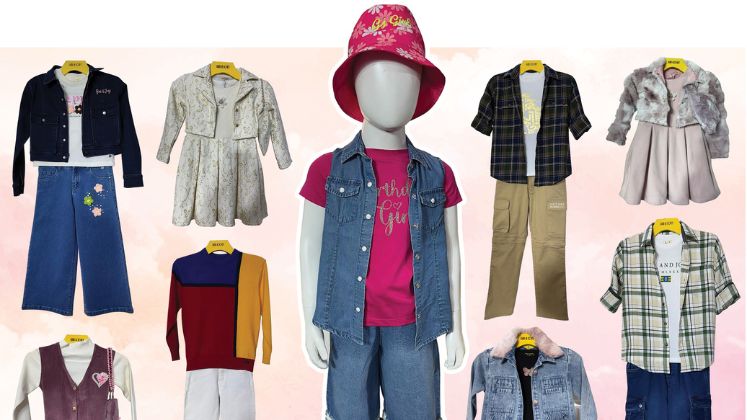Homegrown kidswear brand Gini & Jony is embarking on a new chapter under Suditi Industries, a vertically integrated manufacturer that believes kidswear is a high-potential yet underserved category in India.
Suditi, which acquired Gini & Jony in November 2024 for an undisclosed amount, aims to turn the brand profitable by FY ’26 with an EBITDA margin of 7-8 per cent.
To drive this new chapter, a leadership board has been established, blending experience with fresh perspectives with Pawan Agarwal, MD, Suditi Industries, spearheading strategic decision-making and operational execution, while Prakash Lakhani, Founder of Gini & Jony, remains an integral part of the leadership team, offering invaluable guidance shaped by decades of industry expertise.
“Every decision we make—whether in design, operations or communication—is centred around the journey of a child. While other brands see kidswear as a fraction of their portfolio, for us, it is the entire portfolio. That singular focus is our biggest differentiator,” said Harsh Agarwal, Chief Marketing Officer, Suditi Industries Ltd., to Apparel Resources in an exclusive interview.

Through revamped product lines, omnichannel retail growth and sustainable innovations, Gini & Jony is making a strong comeback, staying true to its legacy while evolving for the next generation, explains Harsh Agarwal. Here are the edited excerpts:
AR: What is Gini & Jony’s price positioning?
Harsh Aggarwal: Gini & Jony is positioned as a premium kidswear brand, distinct from hypermarket or value-driven players. Our focus is on delivering high-quality fabrics, superior craftsmanship and thoughtful design at an accessible yet premium price point.
Price Ladder across Categories:
- T-Shirts – Our entry-level T-shirts start at Rs.499 and go up to Rs.1,299, depending on the design, fabric and detailing. We also offer premium options such as Supima cotton, which falls at the higher end of this range.
- Jeans – Pricing varies by age group. For infants and younger kids, jeans start at Rs. 999, while youth sizes can go up to Rs. 2,499.
- Jackets and Winterwear – These represent our higher-ticket items, starting at around Rs. 2,499 and going up to Rs. 4,999, depending on style and fabric innovation.
- Other Categories – Our product range, covering everything from dresses, joggers and shorts to sweaters and accessories, generally falls within a Rs. 499 to Rs. 4,999 pricing spectrum.
Since kidswear is diverse, we cater to three key segments—infants, kids and youth, with pricing aligned to age-specific product needs. Across all categories, our commitment remains the same: premium, durable and child-friendly fashion that parents can trust.
| Gini & Jony has a strong presence and performance across Tier-1, Tier- 2 and Tier-3 markets. Historically, like most premium brands in India, our growth in Tier-1 cities has been faster due to better retail infrastructure and accessibility. However, the real opportunity for expansion lies in Tier-2 and Tier-3 markets. |
Harsh Agarwal Chief Marketing Officer, Suditi Industries Ltd.
AR: What are the themes and inspirations for Gini & Jony’s Autumn/Winter 2025 collection? Do you follow seasonal collections and how is your category/ distribution mix structured?
Harsh Aggarwal: At Gini & Jony, we approach kidswear differently from conventional fashion brands. Rather than just following seasonal themes or broad market trends, we design with a deep understanding of a child’s journey of discovery. Children’s interests evolve as they grow and we structure our collections around how they engage with the world at different ages.
- 0 to 3 years – Children at this stage are drawn to bright colours, simple shapes and animals. Our designs for this age group focus on engaging visual elements that stimulate early learning and curiosity.
- 3 to 6 years – Kids begin developing preferences for vehicles, tools and adventure-driven themes like monster trucks and dinosaurs, which introduce them to a world beyond basic elements.
- 6+ years and pre-teens – Interests shift toward sports, licensed characters and content-driven themes, including cartoons, anime and pop culture influences.
- Youthwear (10+ years) – This segment aligns more with global youth trends, incorporating sport-driven inspirations and fashion-forward elements.
This philosophy ensures that we create products that resonate with children themselves, rather than just appealing to parental preferences.
Seasonal vs. Thematic Exploration
While our core approach revolves around a child’s developmental journey, we also incorporate seasonality in our collections. For Autumn/Winter, the palette shifts towards deeper, richer tones with themes such as:
- Botanicals and nature – A transition from spring florals to a more muted, earthy aesthetic.
- Adventure and outdoor exploration – Themes like camping, hiking and exploration-based motifs that align with the winter season.
- Festive and cultural inspirations – Given India’s dynamic festive calendar, we create focused drops around key celebrations such as Durga Puja, Diwali and Christmas, ensuring kids have relevant wardrobe choices throughout the season.
For Spring/Summer, the focus shifts to a lighter, brighter aesthetic with themes of beaches, tropical elements and vibrant colours that capture the essence of warm-weather dressing.
Rather than delivering a single large seasonal collection, we operate on a multi-drop model, ensuring a steady flow of fresh fashion throughout the season. Each season comprises 10-12 product drops, tailored to key moments in a child’s wardrobe cycle.
AR: How does Gini & Jony perform across Tier-1, Tier-2 and Tier-3 markets? Where do you see the biggest growth potential?
Harsh Aggarwal: Gini & Jony has a strong presence and performance across Tier-1, Tier-2 and Tier-3 markets. Historically, like most premium brands in India, our growth in Tier-1 cities has been faster due to better retail infrastructure and accessibility. However, the real opportunity for expansion lies in Tier-2 and Tier-3 markets. For over 40 years, Gini & Jony has been one of the few nationally recognised kidswear brands, making it an aspirational choice for parents across India. While accessibility may have been a challenge in the past, today’s retail evolution—driven by e-commerce, omnichannel strategies and improved distribution networks—has made premium brands like ours far more accessible in smaller cities.
Growth Strategy and Market Focus:
- Tier-1 markets – We continue to see strong performance in metro cities, where brand awareness and premium fashion demand are well established.
- Tier-2 and Tier-3 markets – These markets represent the biggest growth opportunity. Parents in these regions aspire to dress their children in trusted, premium-quality brands, and with improved accessibility, we are expanding aggressively in these locations.
AR: How are you integrating omnichannel as a seamless consumer experience?
Harsh Aggarwal: Omnichannel retail is not just about having an online and offline presence—it’s about integrating them to provide a seamless experience for the consumer. Our focus is on leveraging technology to remove friction between channels and improve accessibility.
Some of the key omnichannel initiatives include:
Real-time inventory syncing and cross-channel fulfilment – If a product or size is unavailable in a physical store, customers can place an order in-store and have it shipped directly to their home from another fulfilment centre or online inventory.
Smarter order fulfilment for faster deliveries – Instead of shipping from a single central warehouse, we tap into our retail network to fulfil orders more efficiently, ensuring that customers receive products in the shortest possible time.
Technology-driven consumer convenience – We are continuously investing in new retail technology to enhance customer experience, whether it’s through AI-driven product recommendations, improved personalisation or seamless checkout and return processes.
As newer technologies emerge in the next 1-2 years, we will remain agile, integrating cutting-edge innovations to improve customer interactions and brand accessibility.
AR: What are Gini & Jony’s expansion plans and where do you envision the brand in the next five years?
Harsh Aggarwal: Gini & Jony has long been a market leader in the Indian kidswear segment. Our expansion strategy is twofold: not only to maintain our leadership position but also to actively contribute to the growth of the market itself. India is a fertile ground for growth as it stands out as one of the most promising markets globally, characterised by youthful demographics, with approximately 24.9 per cent of India’s population aged between 0-14 years, underscoring a substantial base of young consumers. The country’s GDP per capita is projected to reach US $ 2,940 in 2025, reflecting a consistent upward trajectory. Also, India’s retail sector is anticipated to grow at a Compound Annual Growth Rate (CAGR) of 6.5 per cent in the fiscal year 2024-25, with both offline and online channels contributing to this surge.
Recognising these favourable conditions, Gini & Jony is poised to capitalise on the burgeoning opportunities through:
- Market penetration: Strengthening our presence in Tier-2 and Tier- 3 cities to tap into the rising purchasing power and brand consciousness in these regions.
- Product diversification: Expanding our product lines to cater to evolving consumer preferences, ensuring we meet the diverse needs of modern parents and children.
- Omnichannel integration: Enhancing our digital platforms and seamlessly integrating them with physical stores to provide a unified and enriching customer experience.
With these strategies in place, we project achieving a turnover in the range of Rs. 700 to Rs. 800 crore within the next five years.







